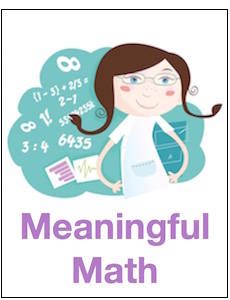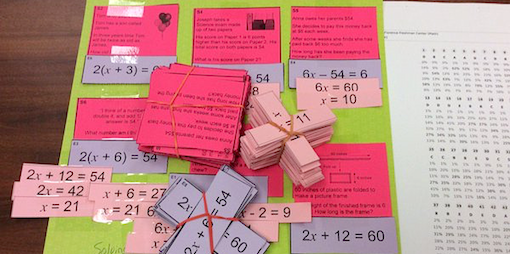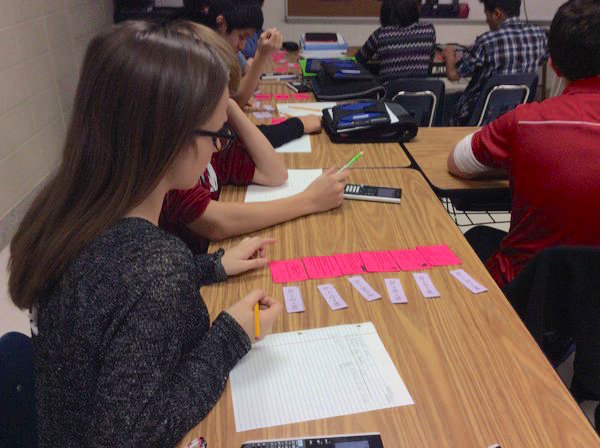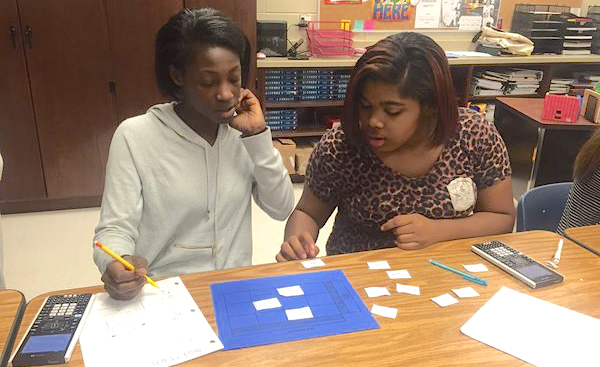Card Sorts Can Promote Meaningful Math Talk
A MiddleWeb Blog
Here’s the first post in MiddleWeb’s new blog about mathematics in the middle grades. Our blogger Michelle Russell will bring her experience as both a middle and high school math teacher to her articles, always with the middle level in focus.

In the past, it was rare for me to hear students having the kinds of mathematical conversations I wanted to hear. I wanted to hear students analyzing, comparing, and even debating about math and math processes. But simply assigning students to work with a partner to complete a worksheet or set of problems did not produce the types of exchanges that I thought they would.
Often, one student would just take over and complete the activity while the other student remained idle. I realized that simply pairing students together was not the answer. So this school year, I’ve relied heavily on card sort activities to promote math conversations among my students.
The what and why of card sorting
Card sorts are not a new activity by any means, and they can take a multitude of forms. In their simplest form, information of some kind is written on a card and students put them in groups based on some criteria.
Sounds simple, doesn’t it? However, just the act of deciding how to group the cards requires students to work at the analysis level. Every time I did a card sort in my classroom this year, I had at least one group surprise and impress me with their thinking. Often, it helped me understand where my students were having difficulties. I could listen to their conversations and see where the stumbling blocks were.
In all honesty, I had tried card sorts in the past and was a little underwhelmed with the results. However, after some reflection I realized that some of my teaching practices were sabotaging the outcomes I wanted to achieve. I had to alter a few of my own behaviors before I achieved the results I was looking for.
Making card sorts more meaningful
One of the adjustments I had to make was to quit being the go-to person when a student had a question. The card sort activity only promotes good conversation if the students are using each other as a resource.
It’s still hard for me not to answer a student’s question directly. In the back of my mind there’s always a little voice saying, “You’re the teacher, it’s your job to answer every question they ask.” I have to remind myself that the point of the card sort is for students to talk to each other.
I also had to realize that sometimes students will say the wrong thing before they say the right thing. It’s not always the best strategy to swoop in and correct a student.
The other adjustment was to only use a card sort when it was relevant and applicable. In the past, I’ve been guilty of using a card sort activity because we had just come back from a long break, or because I didn’t want one class to get ahead of another class. These were not sound reasons to bring out the cards.
To be successful, a card sort needs to be placed strategically into a lesson. I had to decide well in advance what I wanted the card sort to accomplish. Did I want to introduce a concept, reinforce or review, or even assess learning?
Card sorts should lead to a culminating activity
I have also come to see that any card sort activity needs a conclusion. Students need something to bring the activity together. It could be as simple as students sharing out how they sorted their cards and comparing their work with other students. The activity should not simply end when all the cards are matched.
Most recently I had my students complete an activity which required them to match a boxplot (box and whisker) to a frequency graph. There were 16 cards, which meant eight matches.
The only instructions were to match the cards that belong together. Students were to take turns making matches, and each student should be able to clearly explain why they thought the match was correct. I really thought the activity would be over in a matter of minutes. Wrong!
The students carefully weighed the characteristics of the graphs and discussed similarities and differences. What more could a teacher ask for? As I walked around the room, I saw numerous students holding a card and discussing the graphs’ characteristics.
The conversations that I heard would have never come about from simply assigning students problems to work. I know card sorts are not a new invention, but I find them to be highly effective in the right situation.
Have you used card sorts in middle level math? Please share ideas and questions!







































I loved this excerpt: “It’s still hard for me not to answer a student’s question directly. In the back of my mind there’s always a little voice saying, ‘You’re the teacher, it’s your job to answer every question they ask.’ I have to remind myself that the point of the card sort is for students to talk to each other.”
It seems that is one of the most important shifts teachers can make – to allow students to struggle in a productive way and to lead them to understanding through questioning, asking peers, and dipping into a resource.
Can you share some of the tips that you use to help you resist providing answers? Thanks for this interesting blog post!
It turned around for me when I rephrased that to “What is the next question I need to ask to have them figure this out?” I’m still answering but with a question that might move them forward. My students quickly learn that I won’t answer directly but I won’t leave them hanging either. They started to pay closer attention to what I said or what I asked because they figured out that it would be helpful to the cause of figuring out what to do or not do.
Thank you for your comments and question! In all honesty, I am still working on fostering productive struggle in my classroom. However, I found preparation helps this in area. As I prepare the lesson I think about potential places where students might struggle and I try to develop questions to ask them that will move them in the right direction (while avoiding leading questions). Also, I have tried to make it a part of my classroom culture. In the beginning, my students were resistant (they just wanted me to give them an answer) but over time they do assume that responsibility for their learning and become more reliant on themselves and their partners.
Thanks for sharing your experience. Our school is also trying to improve student engagement by recommending more activities. The hope is for the kind of rich discussions that you mentioned. Thanks for giving us food for thought
Great post Michelle. My colleagues and I (in Australia) have looked at how using card sorts can demonstrate physically the complexity of student thinking in mathematics. Here is a blog post with a video showing the students card sorting in high speed! http://chrisharte.typepad.com/learner_evolution_chris_h/2012/10/brains-on-the-solo-table.html
You are so right about students saying the wrong thing before they say the right thing. Most often these are my weaker students who are finding success with the concept being taught, but answer incorrectly because they still struggle with a basic skill. Doing a card sort would allow these students the extra time to get their thoughts together. This would also be a great way to differentiate instruction! I look forward to reading your blog in the future as I transition from teaching high school to middle school. :)
This sounds awesome. I am very excited start math workshop this year and this would a great addition that. especially I build the expectations early on. Do you have any resources that you can share?
Thank you for your comment! There are so many great resources available. I typically start out by just searching on the Internet. Teachers Pay Teachers is another good resource. I am also a big fan of Pinterest. I’m not sure what topics you need, but the MARS (Mathematics Assessment Resource Service) website has many good lessons which include card sorts.
We do these all the time in my Biology classes. I call them SORTABLES! I agree that they get kids talking about the content quickly and keep the academic conversation going until they finish the sort! Love it!
Would you be willing to send me a copy of your template for box plot sort? Sounds awesome! If so, my email is abcdbelair@bellsouth.net.
I just sent you the materials for the box plot card sort. Hope it helps!
I have done this in the past as an intro to “rational vs. irrational” and a few other topics… Thanks for the reminder that this was good!!
Card sorts are a great way to promote discourse and to assess student understanding/mastery. They can be used so many ways: Quiz, Quiz, Trade; Give One, Get One; Rummy; or as a straight up card sort in groups, pairs, or individually. I have a set of cards for proportional relationships on my blog that can be downloaded (all of my stuff is free – we all get better if we share). It also describes how I use them. https://matheasyaspi.wordpress.com/2016/06/02/accommodating-imperfection-proportional-relationships-cards-with-multiple-variations-for-play/
AWESOME! Thank you :)
Love this blog post. I have some cards another teacher prepared and left behind. I am inspired to see how I can use them for teaching economics. I can use your examples and apply to a different content including graphs!